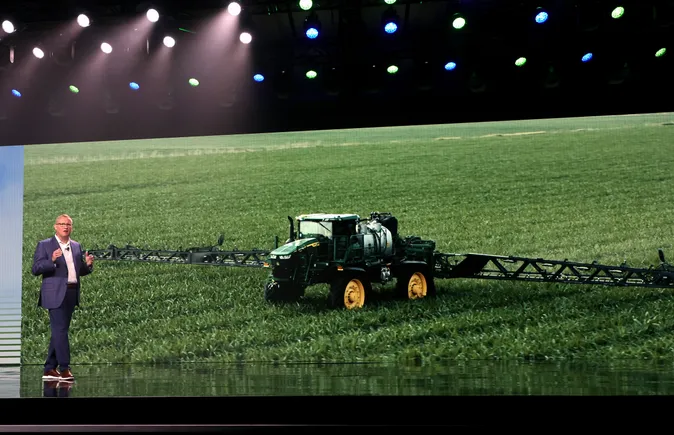Dive Brief:
-
Deere & Co. posted earnings that beat analyst expectations amid a challenging period weighed down by sluggish sales and expenses from widespread layoffs.
-
Deere’s global sales and revenues totaled $13.1 billion in the third quarter, down 17% over last year as farmers continue to pull back spending on tractors, precision technologies and other large purchases. Net income tumbled 42% to $1.7 billion, according to the report.
-
The tractor maker was still able to outperform analyst expectations, somewhat weathering a downturn in demand by sharply reducing production. Chairman and CEO John May said it has cut manufacturing “at a faster pace than ever before,” and expects to end the year with less than one new row crop tractor per dealer.
Dive Insight:
As high interest rates and low commodity prices continue to prevent borrowers from taking out loans on farm equipment, Deere, like other tractor makers this year, has significantly slowed production in response to demand pressures.
To weather the difficult backdrop, Deere has reduced its production days and workforce at a number of Midwestern factories to reign in costs. Last month, it moved to cut an undisclosed number of salaried employees, with Deere’s CFO saying job cuts resulted in “mid-single-digit” reduction of the company’s global workforce.
“While these actions have been hard and certainly not something we take lightly, they help us maintain our competitiveness throughout the business cycle,” May said in an earnings call, “allowing us to continue investing in the products and solutions that empower our customers to address their unique challenges.”
Employee-separation costs totaled $150 million, with $124 million reported in the third quarter. According to the earnings report, workers in the U.S., Europe, Asia and Latin America were affected.
While it was a one-time expense, Jepsen said the decision will deliver $230 million in annual pre-tax savings, driving a more structurally sound, profitable business.
Additionally, Deere’s board approved to sell 50% of the company’s ownership in Banco John Deere, a wholly-owned subsidiary located in Brazil, which resulted in a loss of $15 million in the quarter.
Layoffs, production cuts and other cost-saving measures are expected to position the company to better respond to changes in retail demand.
“Order books across all segments are effectively full for the remainder of the fiscal year, as we position our business to respond to changes in retail demand,” said Josh Rohleder, manager of investor communications. “These actions, along with a continued focus on cost control, are essential to keeping our business healthy as we continue to invest in future growth.”
All of Deere’s businesses — Production & Precision Agriculture, Small Agriculture & Turf, Construction & Forestry, and Financial Services — reported income and revenue or sales declines in the third quarter over last year.
Despite headwinds, analysts were upbeat of Deere’s results given the tough environment. Earnings per share totaled $6.29, up from an expected $5.63, according to figures compiled by Thomson Reuters.
Looking ahead, Deere is expecting net income to be $7 billion for fiscal year 2024, about 30% lower than a year ago and more in line with results from 2022. The company is bracing for agricultural sales to decline 20-25% from 2023.



